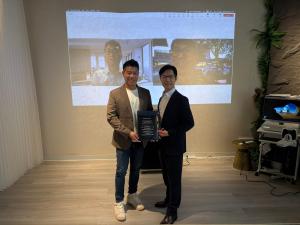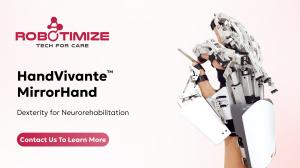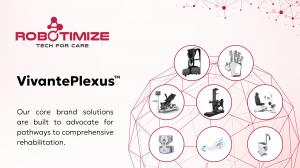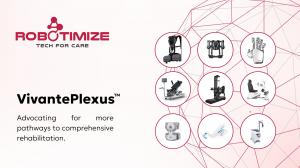MotusAcademy and Rehabotics Unite to Advance Dexterity-Focused Neurorehabilitation via Education, Evidence and Community

Zen Koh (front left) and Charles Huang (front right) hold the signed MoU, witnessed virtually by Dr Pei Yu-Cheng (screen left) and Dr Denny Oetomo (screen right).

HandVivante™: An intelligent hand rehabilitation exoskeleton designed to support personalised therapy, enhance motor recovery, and promote functional independence.

HandVivante™: A next-generation hand exoskeleton delivering intelligent, adaptive therapy to restore dexterity, strength, and fine motor function across all stages of recovery.
Partnership delivers clinician training, joint webinars and real-world evidence, creating an open hub to standardise safe, dexterity-focused care globally.
Summary
* Clinician education and certification: Device Operator and Clinical Applications curricula with assessments and certificates issued by MotusAcademy.
* Webinars and events: Joint webinars and coordinated conference sessions to share practice-ready insights.
* Clinical evidence generation: A multi-site case series using standardised outcomes to build real-world evidence and implementation guidance.
* Open content hub: Thought-leadership posts, short videos and clinical briefs co-published to both communities.
Why Dexterity-Focused Neurorehabilitation Matters
Fine-motor impairment is among the most persistent and disabling consequences of stroke, traumatic brain injury, spinal cord injury and neurodegenerative disease. For patients and families, recovery is ultimately judged not by abstract scores but by the return of purposeful hand use: fastening a button, grasping cutlery, manipulating a phone, writing a signature, or turning a key. These tasks demand a blend of strength, coordination, sensorimotor integration and cognition—capacities that are difficult to restore and easy to overlook when programmes focus narrowly on gross motor milestones.
Over the past decade, rehabilitation technologies have advanced rapidly: sensorised exoskeletons, soft robotics, cooperative robots, task-oriented training systems, and immersive feedback environments now enable high-repetition, data-rich practice that is precisely tuned to patient capability. Yet technology alone does not guarantee outcomes. What matters is how devices are embedded into clinical pathways: the assessment logic clinicians apply, the dosing and progression rules they follow, the safety checks they perform, and the outcomes they measure and review over time.
MotusAcademy and Rehabotics are uniting to close this “last-mile” gap between capability and consistent practice. Their joint programme focuses on clinician readiness, protocol fidelity, and outcomes transparency—three levers that transform promising tools into dependable care.
Closing the Skills and Trust Gap
Around the world, clinicians face a similar challenge: keeping pace with fast-moving product features while retaining a clear grasp of patient-centred reasoning. Many teams also lack access to structured training that ties device operation to validated outcome measures and to the realities of multidisciplinary practice. At the same time, health-system leaders and payers are asking for stronger, longitudinal evidence of functional gains, patient-reported outcomes, and service quality.
The collaboration addresses both needs:
1. Training that starts with clinical reasoning. Rather than teaching buttons and menus first, the curricula begin with indications, contraindications, and decision pathways tied to common patient profiles (e.g., moderate stroke with neglect; early post-operative traumatic nerve injury; mild cognitive impairment with apraxia). Device skills are taught as the means to deliver protocol-based therapy, not as an end in themselves.
2. Standardisation without rigidity. The programme promotes standardised outcomes (e.g., ARAT, Box and Block Test, Nine-Hole Peg Test, grip-pinch measures, PROMs/PREMs) and clear documentation practices, while recognising that clinicians must individualise goals and progressions. The aim is to enable comparable data and reproducible quality without constraining clinical judgement.
3. Transparency and shared learning. Through a joint content hub, webinar series, and conference sessions, the partners will publish case insights, common pitfalls, and “what good looks like” checklists—creating a living library practitioners can adapt locally.
What the Collaboration Delivers
1) Education & Certification
MotusAcademy will lead the design and delivery of two complementary learning tracks:
* Device Operator Certification (DOC). A practical course focused on safe setup, calibration, session execution, troubleshooting, hygiene, and documentation. Assessment includes observed structured clinical examinations (OSCE-style), scenario-based checklists, and short reflective write-ups. Successful participants receive certification from MotusAcademy, recognised within its global community.
* Clinical Applications Certification (CAC). An advanced track for therapists and physicians who design and supervise protocols. Modules cover stratification by impairment and function, dosing and progression logic, integration with conventional therapy, discharge planning, and interpreting outcomes over time. Participants build a mini-portfolio of cases, each with baseline, interim, and follow-up measures linked to patient-centred goals.
Both tracks are blended: self-paced e-learning for foundations, followed by live virtual workshops and hands-on practicums hosted at partner centres. Curricula are mapped to continuing professional development (CPD) expectations and are continuously refined with learner analytics and faculty review.
2) Webinars & Events
The partners will co-host a webinar series designed to be both accessible and rigorous. Each session answers a practical question, for example:
* “What changes tomorrow?” — A 60-minute walkthrough of safe start-up, contraindication checks, and the first three sessions for common profiles.
* “Measuring what matters.” — Selecting, administering and interpreting fine-motor outcomes; linking metrics to patient goals and documentation.
* “From lab to daily life.” — Translating therapy gains to activities of daily living (ADLs), home programmes, and caregiver coaching.
Sessions will feature real case material (with appropriate privacy safeguards), panel dialogue with clinicians and engineers, and concise take-home tools (cheat-sheets, checklists, protocol cards). The series will be complemented by joint sessions at major rehabilitation conferences, where the partners will showcase implementation stories and clinician-authored posters.
3) Clinical Evidence Programme
To build decision-grade evidence for frontline teams and administrators, the partners will coordinate a multi-site case series focused on dexterity outcomes. The approach balances scientific discipline with real-world feasibility:
* Standardised data model. Sites use common data fields for demographics, baseline impairment/function, therapy dose and progression, device modes used, adverse events (if any), and outcomes at pre-defined intervals.
* Pragmatic inclusion. Typical patients seen in routine services—not only “ideal” research participants—are included to reflect day-to-day practice and constraints.
* Outcome triangulation. Clinical scales are complemented by digital task metrics (e.g., repetitions, time-on-task, error rates) and patient-reported outcomes on function and satisfaction.
* Implementation notes. Each case captures “what it took” to deliver care: staffing patterns, scheduling, common bottlenecks, and workarounds. These operational insights are often the difference between a promising pilot and a repeatable service.
The result will be a set of practical briefs—short, plain-language summaries that link outcomes to protocols and operations. These briefs help clinicians set expectations, guide service leaders on investment and staffing, and support quality-improvement cycles.
4) Open Content Hub
Recognising that learning continues at the point of care, the partners will maintain a shared content hub that aggregates:
* Clinical quick-reads (800–1200 words) on protocol design, safety pearls, and troubleshooting.
* Micro-videos (2–5 minutes) demonstrating setup steps, calibration, and patient communication tips.
* Outcome spotlights explaining how to administer and interpret commonly used tests in dexterity rehab.
* Community posts highlighting centre-level innovations and clinician-authored reflections.
All content is written or reviewed by practising clinicians and educators, prioritising clarity over jargon. Pieces will be cross-posted to MotusAcademy and Rehabotics channels to reach the widest relevant audience.
Roles, Quality and Governance
Rehabotics will provide access to devices, technical and clinical documentation, and product experts; validate brand and claims; ensure regulatory accuracy for product content; and maintain product quality and post-market surveillance to ISO 13485:2016. MotusAcademy will lead instructional design, hosting and delivery; coordinate faculty; operate the learning and webinar platforms; apply editorial and peer-review standards; provide analytics to improve learning efficacy; and disseminate content to the community and partners.
A joint Steering Committee—with two representatives from each organisation—will meet quarterly to review progress, approve curricula updates, prioritise evidence topics, and plan public engagements. This cadence ensures the programme stays clinician-centred, outcome-oriented and responsive to new evidence and field feedback.
What Success Looks Like
The collaboration is designed to create measurable value at three levels:
1. For clinicians: Clearer decision pathways, safer and faster onboarding to technology-supported dexterity training, and confidence anchored in both certification and ongoing mentorship.
2. For patients and families: More consistent therapy experiences that connect clearly to daily function, alongside better communication about goals, progress and homework between visits.
3. For services and systems: Greater protocol fidelity across teams and sites; comparable outcomes data to support quality improvement; and practical guidance for workforce planning, scheduling and integration with existing workflows.
While specific targets will be refined with participating centres, both partners are aligned on publishing periodic progress updates so the community can learn from what works—and what needs refinement.
Voices From Leadership
“Clinicians need practical, trustworthy pathways to master dexterity-focused rehabilitation,” said Zen KOH, Founder & CEO of MotusAcademy. “This collaboration is intentionally hands-on: shared curricula, measured outcomes and an open content hub that raises capability across the ecosystem. We are putting clinicians—and their patients’ goals—at the centre of every module, checklist and case brief.”
“We are delighted to partner with MotusAcademy to combine robust clinical training with real-world evidence,” said Charles Huang, Founder & CEO of Rehabotics. “By aligning product expertise with clinician-centred education, we aim to improve safety, consistency and confidence in daily practice. Ultimately, this is about helping patients recover the dexterity that makes independent living possible.”
“Restoring fine hand function is often the most stubborn barrier to independenc," Dr Pei Yu-Cheng. "By pairing rigorous, clinician-centred curricula with transparent outcomes, this collaboration helps teams translate engineering capability into meaningful gains in daily life.”
“Technology only delivers value when embedded in robust clinical pathways," Dr Denny Oetomo. "Standardised protocols, instrumentation-grade data and continuous feedback loops are essential—this partnership creates the scaffolding for consistent, reproducible dexterity rehabilitation at scale.”
Early Focus Areas
To ensure rapid, meaningful impact, the initial programme will prioritise three common clinical scenarios:
1. Post-stroke upper-limb recovery (sub-acute to chronic). Protocols that progress from supported, high-repetition task practice to more demanding bimanual coordination, with attention to neglect, spasticity management and fatigue.
2. Traumatic nerve and orthopaedic injury. Sensor-guided, pain-aware progression from protective mobilisation to dexterity tasks, including graded grip and pinch training aligned with surgical precautions.
3. Parkinsonian syndromes with dexterity deficits. Task-specific speed-accuracy work with cueing strategies, session structuring to address motor fluctuations, and caregiver involvement for home carry-over.
In each scenario, the training emphasises safety gates (screening and contraindications), dose logic (how much, how often, when to progress), and outcome mapping (what to measure, when, and what changes are clinically meaningful). Examples and checklists are designed for rapid adoption in busy clinics.
Building a Learning Community
Beyond formal courses, the partners will cultivate a collaborative community:
* Faculty network. Experienced clinicians will mentor new adopters, contribute case material, and co-author briefs. Faculty development workshops ensure consistent teaching quality.
* Peer exchange. Virtual case rounds and discussion boards allow clinicians to share questions, protocols and lessons learned, fostering a supportive culture of improvement.
* Recognition and CPD. Participants receive certificates and (where applicable) CPD credits, with digital badges to recognise mastery of specific competencies (e.g., safe calibration, outcome administration, protocol design).
* Open calls for evidence. The evidence programme will periodically invite centres to contribute themed case series (e.g., hand dexterity after cervical SCI), with lightweight templates that keep participation feasible.
Call to Participation
Clinicians, rehabilitation services, and academic partners interested in joining the education pathways or contributing to the case series can register interest via MotusAcademy channels. Organisations with established dexterity programmes are invited to share protocols and operational insights that others can adapt. The partners will publish a rolling calendar of webinars and training opportunities, along with guidance for centres wishing to host hands-on practicums.
Signatories and Witnesses
The collaboration was formalised by Zen KOH, Founder & CEO, MotusAcademy, and Charles Huang, Founder & CEO, Rehabotics. The signing was witnessed by Dr Denny Oetomo and Dr Pei Yu-Cheng.
About MotusAcademy
MotusAcademy is a clinician-centred education platform dedicated to advancing practice in rehabilitation technologies through structured training, peer-reviewed content and global community programmes. Its mission is to equip practitioners with the knowledge, skills and tools to deliver safe, effective, technology-enabled care that improves meaningful patient outcomes.
About Rehabotics Medical Technology Co., Ltd.
Rehabotics is a medical technology company focused on neurorehabilitation solutions that support dexterity and functional recovery. Working closely with clinical partners, Rehabotics translates engineering innovation into practical tools for daily practice, with a commitment to product quality, safety and continuous improvement.
Jerry HONG
Robotimize Group
+60 11-1224 1674
email us here
Legal Disclaimer:
EIN Presswire provides this news content "as is" without warranty of any kind. We do not accept any responsibility or liability for the accuracy, content, images, videos, licenses, completeness, legality, or reliability of the information contained in this article. If you have any complaints or copyright issues related to this article, kindly contact the author above.


